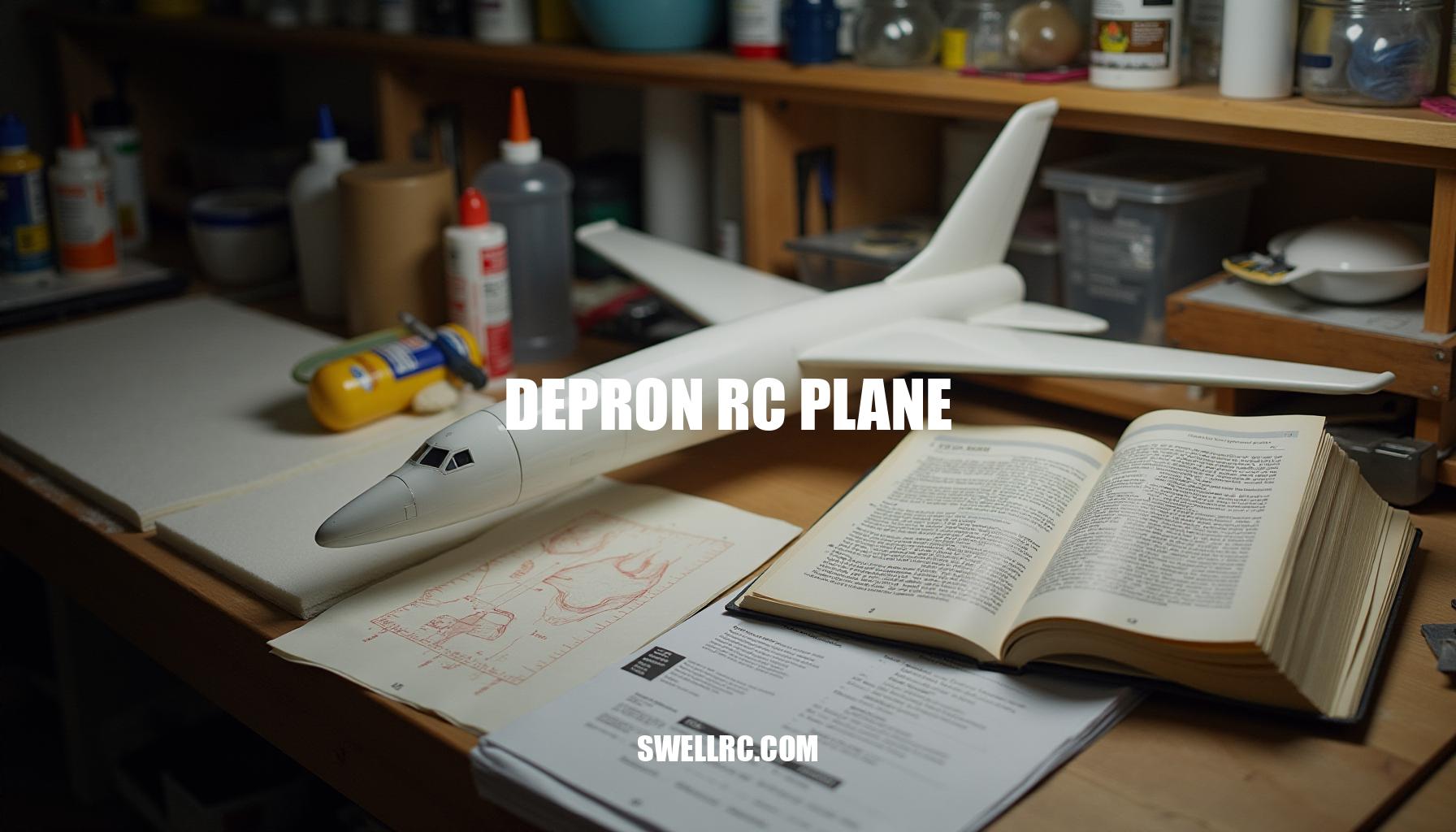Depron RC Plane: The Ultimate Guide to Building Lightweight Aircraft
The first time I hand-launched a Depron RC plane I’d scratch-built from 3 mm sheets, it felt like cheating gravity—feather-light, locked-in, and whisper-quiet. That maiden flight hooked me instantly, and after countless rebuilds and tweaks, Depron foam has become my go-to material for indoor RC models and sub-250 g park flyers. Depron is a closed-cell extruded polystyrene known for its exceptional stiffness-to-weight ratio, which is exactly what you want when every gram matters in lightweight RC aircraft.
Compared with EPP’s bounce-back durability and balsa’s crisp precision, Depron hits a sweet spot for precision flying and ultra-light construction. Its versatility shines through in DIY RC planes, where Depron foam sheets can be expertly crafted into components like 3mm Depron wings that deliver outstanding performance. In this guide, I’ll share what Depron is, why it shines in Depron aircraft design, my proven building techniques, flight-performance takeaways, and ways to push into advanced, competition-grade designs for RC foam planes.
For a deeper primer, see this overview of Depron foam model aircraft: https://www.swellrc.com/depron-foam-model-aircraft/.
What Exactly Is Depron Foam and Why It Dominates Lightweight RC Builds
Depron foam sheets are a popular choice in RC plane construction foam due to their unique properties. Originally developed as fine-celled, extruded polystyrene foam for underlayment and packaging, Depron is now widely used in lightweight RC aircraft for its impressive stiffness-to-weight ratio. Available in 2 mm, 3 mm, and 6 mm thicknesses, standard Depron has a density of approximately 30 kg/m³, while lighter variants like “Aero” grade range between 20–25 kg/m³.
At 3 mm thickness, Depron weighs about 90 g/m², which helps keep wings and fuselages under strict all-up weight (AUW) targets. This reduction in weight results in better wing loading characteristics, lower stall speeds, and a smooth, “connected” feel during slow flight. These advantages make Depron especially suitable for indoor RC models, precision aerobatics, and featherweight park flyers, notably in builds aiming for sub-250 g or ultra-slow F3P-style performance.
When compared to other model aircraft materials, Depron is stiffer than Expanded Polypropylene (EPP) foam of the same thickness but offers less crash resilience. Unlike bead foams, Depron shapes more predictably, lending itself well to detailed and accurate construction. For those exploring material options, resources such as this roundup of RC plane materials and a comprehensive comparison of foams used in RC provide valuable insights.
| Material | Density (kg/m³) | Thickness (mm) | Approx. Weight (g/m²) | Notable Properties |
|---|---|---|---|---|
| Standard Depron | ~30 | 3 | ~90 | Good stiffness-to-weight ratio, predictable shaping |
| Aero Grade Depron | 20-25 | 3 | Lower than standard | Lighter, ideal for ultra-light builds |
| EPP Foam | Varies | Same thickness | Varies | More crash-resistant, less stiff |
In summary, Depron foam sheets offer an excellent balance between rigidity and weight that’ll help enthusiasts achieve clean, efficient builds in the indoor RC and lightweight aircraft segments. Leveraging its properties enables superior aerodynamic performance, especially in applications where every gram counts.
Building with Depron: My Tested Techniques That Actually Work (Step-by-Step)
After many prototypes and learning from broken wings, I’ve developed a precise process for building ultralight RC planes that emphasizes durability and performance. This process begins with careful foam cutting techniques to ensure clean, accurate parts. First, plan and print: start with tiled plans and verify the scale while keeping the all-up weight (AUW) targets visible to avoid any unintended increase in mass during design.
Next, transfer patterns by lightly spray-mounting or pinning templates; it’s crucial to avoid heavy adhesives that can tear the delicate Depron foam cells.
- Cut clean: Utilize a new #11 blade and a steel ruler. Making multiple light passes is far better for precision and surface quality than one heavy cut.
- Score and fold: For curves, lightly score the foam and shape it over a pipe with gentle, moving heat (like a hair dryer) to prevent warps.
- Edge prep: Lightly sand the leading edges and seal them with thin tape or a single coat of water-based polyurethane, which helps resist hanger rash and wear.
- Spars and reinforcements: Adding 0.5×3 mm carbon flat spars in the wings and 1–2 mm carbon fiber rods along the fuselage spine significantly strengthens the structure. Using a tiny bead of polyurethane (such as Gorilla Glue) expands to lock spars in place with minimal added weight, a key technique for how to strengthen Depron RC wings.
- Glue strategy: Dry-fit all components first, then tack with foam-safe CA.
For high-load joints, finalize with UHU POR or epoxy, recognized as the best glue for Depron planes due to its strong bond without damaging foam.
- Hardware install: Reinforce servo bays with thin plywood or a carbon fiber patch, and use either thread or Mylar hinges CA’d into slits to maintain precise control surfaces.
- Weight discipline: Route all wires tightly, use minimal connectors, and consider a 1S battery setup for indoor flight to keep the overall mass low—essential for lightweight RC aircraft builds.
- Final finish: Applying ultra-light laminate film (25–40 µm) or tissue with water-based polyurethane adds durability to the plane’s surface while adding very little mass, making it ideal for sensitive models like those with 3mm Depron wings.
This structured approach is especially beneficial when undertaking DIY RC planes projects focused on indoor and ultralight designs. For more insights, I recommend visiting the super-light indoor builds guide and reviewing trade-offs for sub-250g models at this dedicated page. From experience, avoid hot glue as it’s too heavy, be cautious not to over-cure parts with heat to prevent warps, and never skip spars to reduce flutter and wing failures.
Depron Glue Cheat Sheet (What actually works)
When building DIY RC planes from foam such as Depron, choosing the best glue for Depron planes is crucial for ensuring durability and performance. Different adhesives cater to various needs in RC plane construction foam, from flexible bonding to strong structural joints. Below is a detailed overview of common adhesives used in the hobby:
| Adhesive | Characteristics | Best Uses |
|---|---|---|
| UHU POR (contact) | Excellent primary adhesive; flexible, strong, non-melting | Apply thinly to both sides, let tack, then press for foam-to-foam bonds |
| Foam-safe CA + kicker | Instant tack; brittle if overused | Quick alignment; reinforce high-stress joints with UHU POR or epoxy |
| 5‑min epoxy | Very strong but heavy | Motor mounts, landing gear plates, carbon fiber joiners |
| PU (Gorilla) glue | Expands to fill gaps; foams if excessive | Gap filling around spars or doublers; tape or clamp during curing |
| Hot glue | Fast setting but heavy; can dent Depron | Accessory attachment in a pinch; use minimally |
| PVA/wood glue | Long cure time; moisture prone; may warp thin sheets | Non-critical laminations only |
| Spray adhesives (e.g., 3M 77) | Light mist application; solvent sensitivity | Laminating films; test first to avoid melt damage |
In addition to adhesive selection, mastering foam cutting techniques complements the structural integrity of your RC model. Using sharp blades and precise cutting tools ensures clean edges for better gluing surfaces and overall smoother construction. By combining the proper adhesive with expert foam handling, you can elevate your DIY RC planes to achieve robust and lightweight designs.
Performance and Flight Review: How Depron Changes the Game
Flight feel is where Depron truly clicks. Thanks to its low mass and crisp stiffness, Depron planes achieve quick rotation rates, experience slow and predictable stalls, and exhibit minimal inertia in corrections. This combination is fantastic for precision 3D flying and ultra-slow indoor routines.
Takeoffs are short, and the wing loading feels forgiving, especially when building with 3 mm thickness.
Outdoors, the rigidity provides sharp and responsive handling. However, lightweight airframes constructed from Depron can be susceptible to gusts, requiring enhancements such as added spar caps and thin laminates to improve strength and keep control surfaces true.
If your priority is crash resilience, EPP foam planes are the best choice. In contrast, when precise control and minimum wing loading are essential, Depron is king. For more on the difference between Depron and EPP in RC planes, check out the dedicated EPP-specific insights.
Additionally, well-established commercial brands like Esprit and World Models have demonstrated how thoughtful foam engineering enhances flight performance, balancing structure and equipment selection for optimal results.
Here’s a quick comparison highlighting key aspects:
| Aspect | Depron | EPP |
|---|---|---|
| Weight | Very lightweight, excellent for indoor RC models | Heavier and bulkier |
| Flight Performance | High precision and responsiveness due to low inertia and stiffness | Good for forgiving flight, less precise |
| Wing Loading | Lower wing loading enables slow stalls and sharp maneuvers | Higher wing loading, more stable but less agile |
| Durability | Fragile, requires careful handling and reinforcements outdoors | Highly crash resilient, great for beginners |
Choosing the right foam type significantly influences how your lightweight RC aircraft performs. Leveraging the unique strengths of each material allows pilots to tailor their setups between agility and durability, indoors or out.
Mini Performance Comparison: Depron vs EPP vs Balsa (typical traits)
When selecting materials for RC foam planes and indoor RC models, understanding the difference between Depron and EPP in RC planes is crucial, alongside considering traditional model aircraft materials like balsa wood. Here’s a comparison to guide your choice:
| Material | Characteristics | Applications |
|---|---|---|
| Depron | Lightest for a given stiffness; offers precise tracking; least crash-tolerant | Ideal for indoor/F3P and sub-250 g flyers requiring agility and precision |
| EPP | Most durable and repairable; softer feel in precision aerobatics; slightly heavier for same stiffness | Suited for pilots prioritizing durability and crash resilience in foam models |
| Balsa | Highest structural efficiency with careful build; excellent energy retention and speed; requires more skill and repair time | Preferred for traditional model aircraft materials enthusiasts focused on performance and craftsmanship |
Choosing between these materials depends on your specific needs—Depron excels in precision and lightweight designs perfect for indoor RC models, while EPP provides unmatched durability for more rugged flying. Meanwhile, balsa remains a classic model aircraft material boasting superior performance but demanding higher skill.
Beyond the Basics: Customization and Advanced Builds
Once you’ve mastered straight-plate builds in DIY RC planes, it’s time to push your skills further by exploring advanced techniques for Depron aircraft design. Enhancing stiffness and durability without sacrificing low wing loading is key to maintaining crisp control and responsive flight performance. Here are some proven methods that consistently improve the performance of 3mm Depron wings and entire airframes:
- Carbon architecture: Incorporate flat spars, cap strips, and cross-bracing to eliminate torsional flex.
This approach is especially crucial for achieving crisp aileron authority in F3P RC planes.
- Laminating film: Apply a 25–40 µm film layer over wings and fuse to enhance ding resistance with less than 5% weight penalty, protecting your delicate foam surfaces during rough landings.
- 3D-printed details: Use custom-printed hinges, control horns, and servo trays designed to key perfectly into Depron slots, ensuring precise alignment and repeatability in control surfaces.
- Removable gear: Employ magnets on canopies and either rubber-band or 3D-printed gear plates. This setup helps your plane survive hard landings by preventing damage to the airframe.
- Hybrid builds: Combine Depron cores with balsa leading edges or ribs for razor-straight wings. This fusion leverages the best characteristics of both materials to improve strength where needed.
For further inspiration, study the intricacies of F3P RC planes patterns and airframes available at SwellRC F3P Collection.
To explore hybrid ideas, check out glider and structural concepts from balsa kits at SwellRC Balsa Glider Kits. These resources showcase how to strengthen Depron RC wings creatively while maintaining lightweight performance.
After testing various variations, my simple rule of thumb for how to strengthen Depron RC wings is to add stiffness only where the airframe ‘talks’—that is, where you experience buzz, flutter, or imprecise tracking—and then stop. This strategy helps preserve the magical low wing loading and agility that make Depron aircraft design so rewarding.
Conclusion – Why Depron Remains My Favorite Material for RC Flight
Depron offers surgical precision at a featherweight mass, a vital characteristic that translates directly into slow, confident flying and aerobatics that feel almost effortless. Over the years of working with Depron foam sheets, my experiences in cutting, gluing, and re-maidening have taught me invaluable lessons:
- Keep builds simple to maintain structural integrity without adding unnecessary weight.
- Reinforce only where the loads truly demand it, optimizing strength-to-weight ratio.
- Choose adhesives carefully based on the job requirements, not just convenience, to ensure durability and performance.
Depron remains crucial in the world of DIY RC planes, powering everything from beginner-friendly indoor RC models to competition-grade F3P ships. Its versatility and lightness make it a go-to material for building lightweight RC aircraft that perform exceptionally well.
Currently, my next project on the bench is an ultra-slow 3D profile plane featuring a refined carbon fiber spine and film-skimmed wings.
This build aims to push the boundaries on the question, “how light can a Depron plane be built?”—all without sacrificing the crucial control feel that pilots rely on for precise maneuvers.
Frequently Asked Questions
- What makes Depron a good material for RC planes?
Its stiffness-to-weight ratio is outstanding, so you get straight, true surfaces with minimal mass. That means lower wing loading, slower stall speeds, and precise control—ideal for indoor and sub‑250 g builds. - How strong and durable is Depron compared to EPP foam?
Depron is stiffer and more precise but less impact-tolerant. EPP is tougher in crashes and better for rough outdoor flying; Depron rewards careful handling with sharper flight response. - What’s the best thickness of Depron for building RC aircraft?
3 mm is the sweet spot for most indoor and light park flyers; use 2 mm for micro components and 6 mm for fuselage sides, wing cores, or high-load areas. Add carbon spars instead of jumping to thicker foam everywhere. - Can Depron planes be used outdoors?
Yes, in calm to moderate conditions. Add spar caps, a light laminate film, and secure hardware; expect more wind sensitivity than heavier or EPP-based models. - How do I repair or reinforce a damaged Depron RC plane?
Wicked-in foam-safe CA closes clean cracks; reinforce with a thin CF strip or tape along the grain of the stress. For crushed edges, splice in a new Depron insert and fair with light sanding. - What are the best flight models to build with Depron?
Profile 3D planes, F3P aerobats, slow flyers, and sub‑250 g park models. Flat-plate wings with CF spars are quick to build and fly beautifully indoors. - Are Depron planes suitable for beginners or only experienced builders?
Beginners can succeed with simple, flat-plate designs and careful adhesive choice. They’re inexpensive to build and teach great weight discipline—just be mindful of crash durability. - How does Depron compare to balsa in performance and weight?
Balsa can achieve superb stiffness and energy retention but often requires more build time and skill. Depron gets you very light airframes quickly, with excellent low-speed handling and easy repairs.



